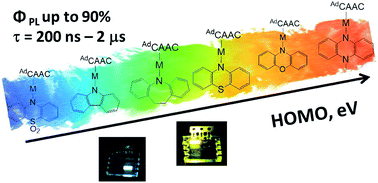Carbene metal amide photoemitters: tailoring conformationally flexible amides for full color range emissions including white-emitting OLED
Published:
Authors: AS Romanov, STE Jones, Q Gu, PJ Conaghan, BH Drummond, J Feng, F Chotard, L Buizza, M Foley, M Linnolahti, D Credgington, M Bochmann

Conformationally flexible “Carbene–Metal–Amide” (CMA) complexes of copper and gold have been developed based on a combination of sterically hindered cyclic (alkyl)(amino)carbene (CAAC) and 6- and 7-ring heterocyclic amide ligands. These complexes show photoemissions across the visible spectrum with PL quantum yields of up to 89% in solution and 83% in host-guest films. Single crystal X-ray diffraction and photoluminescence (PL) studies combined with DFT calculations indicate the important role of ring structure and conformational flexibility of the amide ligands. Time-resolved PL shows efficient delayed emission with sub-microsecond to microsecond excited state lifetimes at room temperature, with radiative rates exceeding 10$^{6}$s$^{−1}$. Yellow organic light-emitting diodes (OLEDs) based on a 7-ring gold amide were fabricated by thermal vapor deposition, while the sky-blue to warm-white mechanochromic behavior of the gold phenothiazine-5,5-dioxide complex enabled fabrication of the first CMA-based white light-emitting OLED.
Recommended citation: A. S. Romanov. (2020). “Carbene metal amide photoemitters: tailoring conformationally flexible amides for full color range emissions including white-emitting OLED.” Chem. Sci.. 11.
